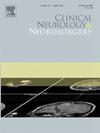Tirofiban vs. aspirin in patients with acute ischemic stroke: A meta-analysis of randomized clinical trials
IF 1.8
4区 医学
Q3 CLINICAL NEUROLOGY
引用次数: 0
Abstract
Background and objectives
Antiplatelet therapy is recommended as the standard treatment for patients with acute ischemic stroke (AIS) who, for several reasons, did not receive thrombolysis or thrombectomy. However, whether tirofiban or aspirin provides greater benefits for these patients remains unclear. Therefore, we aimed to perform a meta-analysis comparing the functional outcomes and hemorrhagic risks associated with tirofiban and aspirin in the management of AIS.
Methods
We searched PubMed, EMBASE, Web of Science, and Cochrane Library for studies comparing tirofiban to aspirin in patients with AIS who did not receive thrombolysis or thrombectomy until September 2024. Outcomes were modified Rankin Scale (mRS) and mortality at 90 days, symptomatic intracranial hemorrhage, and any bleeding events. Statistical analysis was performed using the R Studio (version 2024.04.1+748).
Results
We included 3 randomized controlled trials with a total of 1959 patients, of whom 996 (50.8 %) were in the tirofiban group. Excellent (mRS 0–1) functional outcome (RR 1.25, 95 % CI: 1.05–1.49; I2 = 70 %) and favorable (mRS 0–2) functional outcome at 90 days (RR 1.09, 95 % CI: 1.01–1.16; I2 = 35 %) were significantly higher in tirofiban compared to aspirin. Furthermore, tirofiban showed no difference in mortality (RR 0.77, 95 % CI: 0.24–2.53; I2 = 56 %), or symptomatic intracranial hemorrhage (RR 3.42, 95 % CI: 0.27–43.30; I2 = 38 %). However, any bleeding event (RR 1.75, 95 % CI: 1.25–2.45; I2 = 0 %) was more common in the tirofiban group. Lastly, the meta-regression analysis showed that the outcomes were not influenced by the initial NIHSS of the included studies (p > 0.05).
Conclusion
Tirofiban is associated with better functional outcomes at 90 days, with no difference in mortality. Additionally, despite being associated with higher bleeding events, there is no difference in symptomatic intracranial hemorrhage. Therefore, our results suggest that tirofiban is a promising alternative to aspirin.
治疗急性缺血性脑卒中患者的替罗非班与阿司匹林:随机临床试验的荟萃分析。
背景和目的:对于因多种原因未接受溶栓或血栓切除术的急性缺血性卒中(AIS)患者,建议将抗血小板治疗作为标准治疗方法。然而,替罗非班或阿司匹林是否能为这些患者带来更大的益处仍不清楚。因此,我们旨在进行一项荟萃分析,比较替罗非班和阿司匹林在AIS治疗中的功能性结果和出血风险:我们检索了 PubMed、EMBASE、Web of Science 和 Cochrane Library,以寻找在 2024 年 9 月之前未接受溶栓或血栓切除术的 AIS 患者中比较替罗非班和阿司匹林的研究。研究结果包括改良Rankin量表(mRS)和90天死亡率、症状性颅内出血以及任何出血事件。统计分析使用 R Studio(版本 2024.04.1+748)进行:我们纳入了3项随机对照试验,共有1959名患者,其中996人(50.8%)属于替罗非班组。与阿司匹林相比,替罗非班的功能预后极佳(mRS 0-1)(RR 1.25,95% CI:1.05-1.49;I2 = 70%),90 天后功能预后良好(mRS 0-2)(RR 1.09,95% CI:1.01-1.16;I2 = 35%)。此外,替罗非班在死亡率(RR 0.77,95 % CI:0.24-2.53;I2 = 56 %)或症状性颅内出血(RR 3.42,95 % CI:0.27-43.30;I2 = 38 %)方面没有差异。然而,任何出血事件(RR 1.75,95 % CI:1.25-2.45;I2 = 0 %)在替罗非班组更常见。最后,元回归分析表明,纳入研究的结果不受初始 NIHSS 的影响(P > 0.05):结论:替罗非班与更好的90天功能预后相关,但死亡率没有差异。此外,尽管替罗非班与较高的出血事件相关,但无症状性颅内出血并无差异。因此,我们的研究结果表明,替罗非班有望成为阿司匹林的替代药物。
本文章由计算机程序翻译,如有差异,请以英文原文为准。
求助全文
约1分钟内获得全文
求助全文
来源期刊

Clinical Neurology and Neurosurgery
医学-临床神经学
CiteScore
3.70
自引率
5.30%
发文量
358
审稿时长
46 days
期刊介绍:
Clinical Neurology and Neurosurgery is devoted to publishing papers and reports on the clinical aspects of neurology and neurosurgery. It is an international forum for papers of high scientific standard that are of interest to Neurologists and Neurosurgeons world-wide.
 求助内容:
求助内容: 应助结果提醒方式:
应助结果提醒方式:


